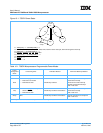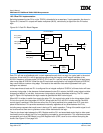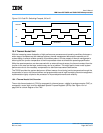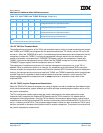
User’s Manual
IBM PowerPC 750GX and 750GL RISC Microprocessor
gx_10.fm.(1.2)
March 27, 2006
Power and Thermal Management
Page 343 of 377
10.4 Thermal Assist Unit
With the increasing power dissipation of high-performance processors and operating conditions that span a
wider range of temperatures than desktop systems, thermal management becomes an essential part of
system design to ensure reliable operation of portable systems. One key aspect of thermal management is
ensuring that the junction temperature of the microprocessor does not exceed the operating specification.
While the case temperature can be measured with an external thermal sensor, the thermal constant from the
junction to the case can be large, and accuracy can be a problem. This might lead to lower overall system
performance due to the necessary compensation to alleviate measurement deficiencies.
The 750GX provides the system designer an efficient means of monitoring junction temperature through the
incorporation of an on-chip thermal sensor and programmable control logic to enable a thermal-management
implementation tightly coupled to the processor for improved performance and reliability.
10.4.1 Thermal Assist Unit Overview
The on-chip thermal assist unit (TAU) is composed of a thermal sensor, a digital-to-analog converter (DAC), a
comparator, control logic, and four dedicated Special Purpose Registers (SPRs). See Figure 10-4 on
page 344 for a block diagram of the TAU.
Figure 10-3. Dual PLL Switching Example, 3X to 4X
SYSCLK
3X
4X
GCLK
clk blocked


















